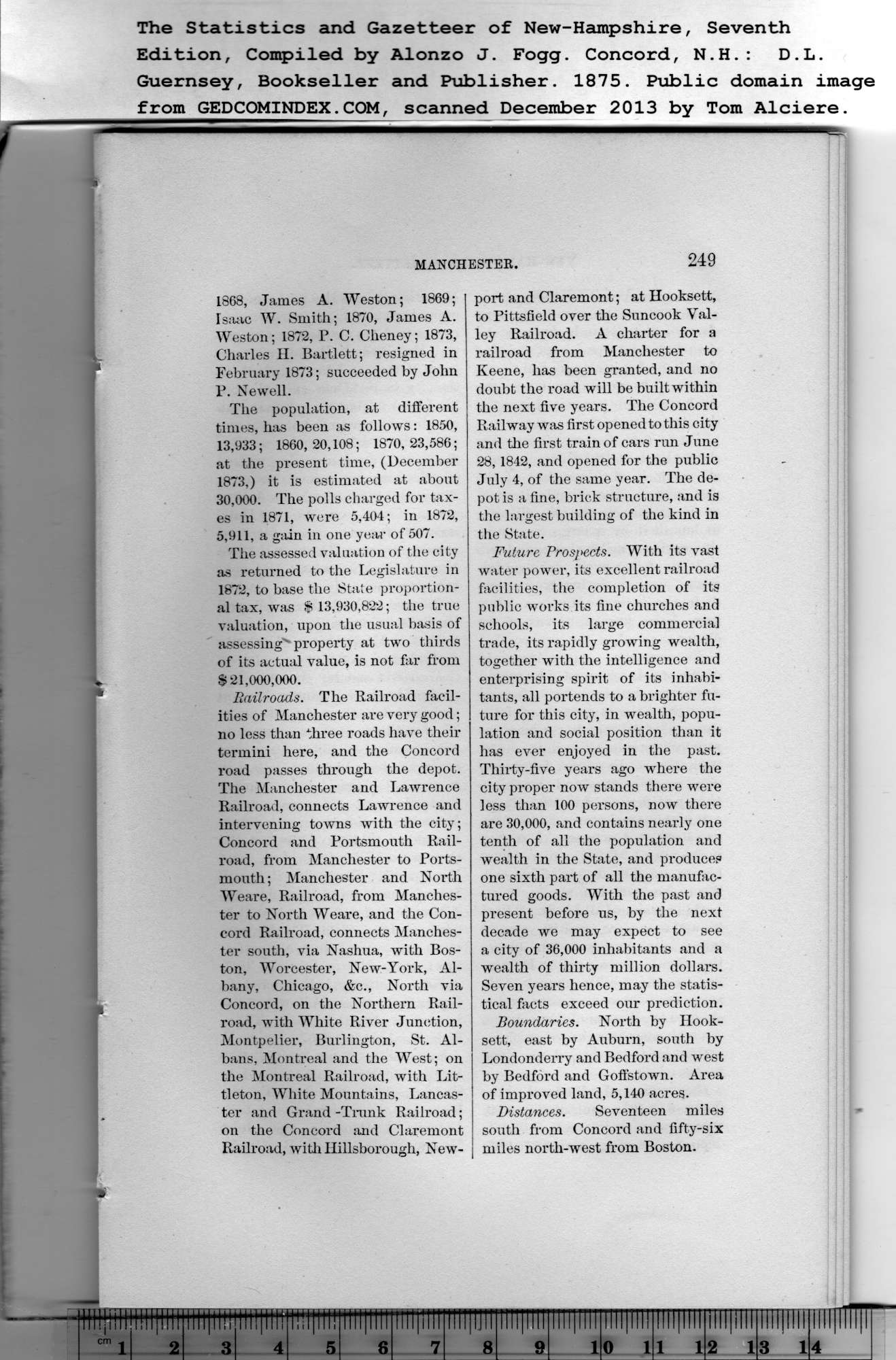|
1868, James A. Weston; 1869;
Raac W. Smith; 1870, James A.
Weston; 1872, P. C. Cheney; 1873,
Charles II. Bartlett; resigned in
February 1873; succeeded by John
P. Newell.
The population, at different
times, has been as follows: 1850,
13,933; 1860,20,108; 1870,23,586;
at the present time, (December
1873,) it is estimated at about
30,000. The polls charged for tax-
es in 1871, were 5,404; in 1872,
5,911, a gain in one year of 507.
The assessed valuation of the city
as returned to the Legislature in
1872, to base the State proportion-
al tax, was $ 13,930,822; the true
valuation, upon the usual basis of
assessing' property at two thirds
of its actual value, is not far from
$21,000,000.
Railroads. The Railroad facil-
ities of Manchester are very good;
no less than three roads have their
termini here, and the Concord
road passes through the depot.
The Manchester and Lawrence
Railroad, connects Lawrence and
intervening towns with the city;
Concord and Portsmouth Rail-
road, from Manchester to Ports-
mouth; Manchester and North
Weare, Railroad, from Manches-
ter to North Weare, and the Con-
cord Railroad, connects Manches-
ter south, via Nashua, with Bos-
ton, Worcester, New-York, Al-
bany, Chicago, «&c., North via
Concord, on the Northern Rail-
road, with White River Junction,
Montpelier, Burlington, St. Al-
bans, Montreal and the West; on
the Montreal Railroad, with Lit-
tleton, White Mountains, Lancas-
ter and Grand -Trunk Railroad;
on the Concord and Claremont
Railroad, with Hillsborough, New-
port and Claremont; at Hooksett,
to Pittsfield over the Suncook Val-
ley Railroad. A charter for a
railroad from Manchester to
Keene, has been granted, and no
doubt the road will be built within
the next five years. The Concord
Railway was first opened to this city
and the first train of cars run June
28, 1842, and opened for the public
July 4, of the same year. The de-
pot is a fine, brick structure, and is
the largest building of the kind in
the State. |
Future Prospects. With its vast
water power, its excellent railroad
facilities, the completion of its
public works its fine churches and
schools, its large commercial
trade, its rapidly growing wealth,
together with the intelligence and
enterprising spirit of its inhabi-
tants, all portends to a brighter fu-
ture for this city, in wealth, popu-
lation and social position than it
has ever enjoyed in the past.
Thirty-five years ago where the
city proper now stands there were
less than 100 persons, now there
are 30,000, and contains nearly one
tenth of all the population and
wealth in the State, and produce?
one sixth part of all the manufac-
tured goods. With the past and
present before us, by the next
decade we may expect to see
a city of 36,000 inhabitants and a
wealth of thirty million dollars.
Seven years hence, may the statis-
tical facts exceed our prediction.
Boundaries. North by Hook-
sett, east by Auburn, south by
Londonderry and Bedford and west
by Bedford and Goftstown. Area
of improved land, 5,140 acres.
Distances. Seventeen miles
south from Concord and fifty-six
miles north-west from Boston. |
